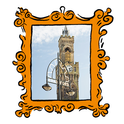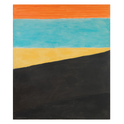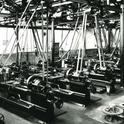At the Venice Biennale, which opened to much fanfare earlier this month, there is a big, bad boat. A boat in Venice is to be expected at the very least—and especially so at the Arsenale, the sprawling complex of former shipyards famously cited for its grandeur and scale in Dante’s Inferno that once armed the Venetian Republic, before the Industrial Revolution normalized mass production.
Still, the big, bad boat leaves a remarkable impression—but, perhaps, for the wrong reasons. Hoisted from the waters off the banks of the Arsenal and dubbed “Barca Nostra” (“Our boat”), it stands mere feet above the ground, blocked atop steel beams. The boat’s hull is breached, irreparably split on the port side offering a window into the hollowed hold. The pain job is rusted and worn with a patina of bruises and scrapes, but otherwise clean from dried flotsam or debris. It’s surprisingly plain.
Its past, however, tells a different story: it was on this boat that somewhere between seven and eleven hundred people died when it sunk between Libya and the Italian island of Lampedusa on April 18, 2015.
“The project facilitates a symbolic transfer of the status of the shipwreck,” we’re told in a press release by Icelandic-Swiss artist Christoph Büchel, whose contribution to the show stands cordoned off but unlabeled near the back of the Biennale.
“[It] changes its legal status from a former object of court evidence to an artifact, [from being] considered a ‘special vessel to be disposed of’ by ministerial decree, to a ‘bene cultural’, a significant symbol of our ‘interesting times’ and collective complicity and memory, resulting in its first public exhibition at the Arsenale in Venice.”
The struggles of the “Barca Nostra” are two-fold. After the shipwreck was recovered in 2016, the bodies that had been trapped in the hold were identified and the boat was parked at a naval base in Sicily, Büchel embarked on a two-year-long battle to bring it to Venice. “No one was the official owner of the boat,” curator and collaborator Maria Chiara di Trapani told the Guardian.
Like most shipwrecks, it was to be destroyed, but with the help of Sebastiano Tusa—Sicily’s councillor for cultural heritage—Büchel’s team managed to circumnavigate the twisted Italian bureaucracy, with discussions with customs officials lasting to days before the Biennale’s opening. Tragically, amidst negotiations to green light the boat’s transport from Sicily to Venice, Tusa died while the papers were still being processed as a passenger aboard Ethiopian Airlines Flight 302, which crashed six minutes after take-off from Addis Ababa on March 10.
Despite its poignant origin story, however, as an image of our times “Barca Nostra” is more heavy-trodden trope than “significant symbol.” In this respect, it joins a nascent canon of images and artefacts supposedly imbued with meaning—by loss, by pain, and with a pathos succinctly summarizing the struggles that came to their creation.
To some, these artefacts act as a symbol of closure—a talisman for what has come before. At the National September 11 Memorial & Museum in New York City, there are remains from all seven of the buildings that made up the World Trade Centre alongside recordings and photographs from the immediate aftermath at Ground Zero. There’s a fire engine, too, mangled by the heat and impact of the towers collapsing.
11 of the first responders were aboard the Ladder Company 3 truck on September 11; nearly a decade later, the city fire engine was laid to rest, draped in a ceremonial flag and lowered into the site where the museum was under construction. “It’s almost like saying goodbye again,” a sibling of one of the firefighters told CBS News. “It’s also more closure.”
In Venice, however, the boat stands alone, unadorned and soundtracked by the chatter of orders at the nearby cafe across the footpath from “Barca Nostra.” It may gesture towards the unforgiving journeys that hundreds die trying to make as a talisman—but it does so quietly, and it is not clear where the gestures point to, or from whom they issue.
There’s a disconnect between the material reality and the metaphor that the “Barca Nostra” is meant to embody: the innumerable hours and countless Euros spent to recover the boat laid to rest the remains of those who tragically lost their lives, but to wield it as a travelling memento mori reduces the lost lives to a symbol.
Endurance art–the slow, participatory, patience-as-an-art-piece practised by Marina Abramovi and her contemporaries, for example–renders the artist’s time, energy and discomfort into a metaphor for greater human meaning. “Barca Nostra,” however, is a negotiation between government bodies and gatekeepers: Those who first endured displacement and, later, death at the hands of these same governments feel like an afterthought, kept absent from the process that makes an allegory of their lives and deaths.
Yet borders aren’t metaphors, and those kept on the outside deserve to be considered and supported both before and after their deaths. I think of the photographs of Alan Kurdi, which were widely circulated a few months after “Barca Nostra” sunk in 2015. Kurdi’s death became a synecdoche for the innocence of those risking their lives to cross the Mediterranean to a continent that presumed their guilt. But Kurdi was not a symbol: He was a child, a three-year-old Syrian boy of Kurdish descent, his death nothing short of a tragedy.
The Pavilion of the Republic of Kosovo, which is quietly cloaked by black curtains, stands a short walk from Büchler’s boat. “Today when I see news about refugees around the world, I get goosebumps, because I know that in 1999, my family also experienced what refugees today around the world are experiencing,” Agim Shala recounts in a video projected across a canvas in the darkened room. Agim is one of the four on-camera protagonists of “Family Album” by Alban Muja. Along with fellow talking heads Besa, Besim and Jehona, Agim was one of the faces of the Kosovan War in the late 90s.
Standing at the Republic of Kosovo’s pavilion, the boat feels as hollow and empty as it is. A feat of Sisyphean bureaucratic dealings, the effort required to bring it to the Biennale eclipses rather than emphasises the human cost of the boat and its painful history. Despite its creator’s hopes, the Biennale’s big, bad boat exists more as an empty gesture than a reminder of anything but art’s limited material consequences.
On screen, Agim describes his grandparents standing outside the refugee camp in which his family was stationed. As they waited to be admitted, they wanted to hold Agim in their arms—he had their son’s name–and American photographer Carol Guzy captured the moment that Agim passed through a barbed wire fence from his uncle’s hands to his grandparents, swaddled in a bright teal jumpsuit.
“It’s something about being completely at the mercy of the events happening around you, and being unable to protect yourself–children especially–that reaches the heart and soul of people,” Guzy told NPR in 2015 as she explained why people find photographs of children particularly moving shortly after the photos of Alan Kurdi began to circulate.
But for Agim, who lived through the war as a refugee himself, it’s not this image that his family treasures: “Even though the photography became widely known, in our living room we keep a portrait of late uncle Agim. That is the only photo in our living room. There are no others.”
A supposedly poignant symbol of the migrant crisis, the Venice Biennale's big, bad boat says more about bureaucracy than anything else
Despite its creator’s hopes, "Barca Nostra" points more to the limits of art than to the human tragedy that forms its origin story
May 20, 2019

Visitors walk near the Barca Nostra in Venice. Photo: PA











